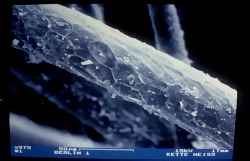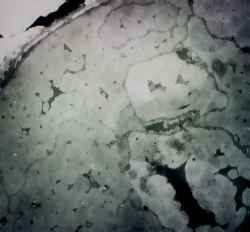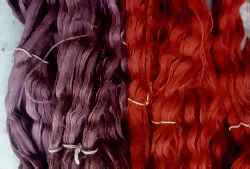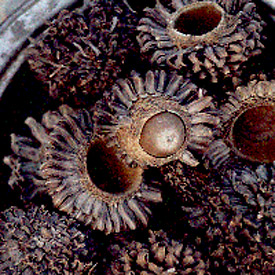
Home Page Discussion
The Salon du Tapis d'Orient is a moderated discussion group in the manner of the 19th century salon devoted to oriental rugs and textiles and all aspects of their appreciation. Please include your full name and e-mail address in your posting.
Salon 134: Natural Dyeing and Natural Dyestuffs in Anatolia
by Manfred Bieber
Natural Dyeing
The art of dyeing using natural dyestuffs is as old as the art of producing coloured textiles. In the cultural evolution of mankind, such capabilities were aquired on the basis of trial and error over relatively long periods of time and then applied as efficient techniques. This is documented a thousandfold in the descendants of the Pazyryk carpet through the ages. This picture shows the Animal Carpet, 17th century, on display in the Vakiflar-Musum, Istanbul.

Dyeing is based on complex interactions between natural polymers, as for example wool or silk, and colour-specific dyestuffs of the anthraquinone, flavone or indigo series.

Red and violet colour shades from madder (Rubia tinctorum), and blue and black colour shades from indigo in combination with madder on wool.

Natural dyeing on silk with Rhamnus petiolaris (yellow and green). Red, brown and violet dyeing on silk with cochinille.
In recent years, modern analytical techniques have made it possible to examine and document the chemistry of natural deystuffs in detail. This is also substantiated by Schweppes book published in 1993. In contrast to this, the biochemical reactions on hair structures before and during the dyeing process are still more or less unclear. The knowledge of these processes is, however, of fundamental importance, if we are to understand the mechanics of natural dyeing, since neither farmers nor nomads of the oriental region had access to complicated dyeing processes. Dyeing techniques applied by farmers and nomads are based on experience handed down through the generations.
It is the simplicity of the dyeing process that results in the well known reproducibility and efficiency. Organic chemical considerations, which are laid down in recent specialist literature in the form of innumerable dye formulae and mixtures, are of no relevance to the traditional natural dyeing process in Anatolia. This aspect of carpet manufacturing has always been neglected in oriental carpet research, as is proven by the very low number of quotable sources.
Expeditions made by V.G.Moschkova between 1929 to 1945 to the carpet
making peoples in Central Asia document a multitude of old dyeing
techniques being applied in these regions. Among other things, the
following procedure was described: "They cooked millet flour in water,
added a handful of alum, let the solution ferment for five days and
then immersed the wool yarn in this solution for a period of ten days.
It was only then, that madder-dyeing was started."
These references
culled from the literature were to give birth to a methodological
concept designed to address the following issues:
1. Reproducibility of the fermentation process described, and definition of its basic microbiological principles.
2. Effects of the fermentation procedure on the microstructure of the
hair and their consequences for natural dyeing processes.
3. Application of the results to the hair structure of antique Anatolian carpets and flatweaves.
1. Reproducibility of the fermentation process described, and definition of its basic microbiological principles:
Fermentation is commonly understood to comprise those biochemical
processes which are initiated by microorganisms and serve in particular
to prepare and preserve food. Well known examples for this are
alcoholic and lactic acid fermentation, i.e., in the case mentioned
above, the formation of a uniform germ spectrum comprising Geotrichum
yeast spores, Saccharomyces yeast spores and lactic acid bacteria on a
barley and millet substrate. The same germ spectrum can be obtained
when wheat bran is used as a basis. An acceleration of the fermentation
process is achieved by adding sourdough to the fermentation solution.
Sourdough contains yeast spores of the Saccharomyces type, which are associated with other yeast spores of the Geotrichum type. If wheat bran is selected as the substrate, the growth of the Geotrichum is strongly promoted. The addition of alum to the fermentation solution does not affect the formation of the germ spectrum described above. When the microbial growth optimum is reached, the acidity of the fermentation solution falls to a pH of 4.4. These environmental conditions are characterised on the one hand by excellent long term stability, on the other, they prevent the growth of putrefactive bacteria. Thus, it can be ensured that wool yarn does not rot during the mordanting process in the fermentation solution.

2. Effects of the fermentation procedure on the microstructure of the hair and their consequences for natural dyeing processes.
The scanning electron micrograph shows the outer hair structure to be an even pattern of overlapping scales. Sheeps' wool comprises two ore three layers of scales. For mordant salts and dyestuffs this outer layer represents the first barrier on their way interior of the hair. The effect of the Geotrichum yeast spores on the hair structure is now apparent. The scale layers of the wool hair exfoliated to a clearly visible extent proportionate to the immersion time of the wool yarns in the fermentation solution.
This procedure is characterised by high enzyme activity of the Geotrichum, which results in a decomposition of fatty substances between the scale layers. The diffusion of mordant salts and dyestuffs into the inner hair cortex is considerably faciliated by this.

Picture above: madder-dyed wool hair, no fermentation. Center Picture: madder-dyed wool hair, 7 days fermentation. Picture below: madder-dyed wool hair, 20 days fermentation. The properties of the wool yarn are not changed by the fermentation process described, whereas the binding capability of the natural dyestuff to the wool fibre is coniderably enhanced. This effect can be proved by means of an endurance test under direct sunlight.

The picture shows yellow dyeing on wool with Rhamnus petiolaris proved by a one year endurance test under direct sunlight in Istanbul, 1984.
The following photograph shows the section of a 0.04 mm thick, fermented wool hair viewed through a scanning electron microscope at 5,000-fold magnification after fixing by means of osmium acid and contrasting by means of heavy metal salts. In the left half of the photgraph, the cuticula-exfoliation from the hair cortex can be seen - marked by arrows. This can be ascribed to the above mentioned effects of fermentation. The hair cortex itself is noticeably divided into two sections: a darker section, the keratin fibres are systematically ordered in the form of bundles, whereas in the lower section, the fibres are arranged more randomly. The spaces between the fibres, which represent the cell interstices in the growing hair, are filled by a matrix.

During the preparation process for electron microscopic examination,
it is the matrix of the fermented wool hair (left side) which is
coloured in intense black. This phenonemon can be traced back to an
increased metal ion concentration. The results suggest that with the
fermented wool hair, mordants can more easily penetrate into the
interior of the hair, this being made possible by the exfoliation of
the outer scale layers. Neither the wool fibres nor the matrix of the
wool hair is structurally changed by this fermentation process.
Unfermented wool hair doesn`t show this effect (right side).

Application of the results to the hair structure of antique Anatolian carpets and flatweaves
Technological procedures leave traces on material processed. Assuming that the hypothesis that fermentation methodology lies behind handed-down dyeing techniques in the Anatolian region is true, tests with antique carpets and flatweaves should lead to reproducible results, as already illustrated in detail under point one and two. However, results obtained from first samples were hardly encouraging, since the outer cuticula of most of the wool hair was in most cases missing. Incidentally, this is the reason for the silky surface of antique textiles.

A systematic series of tests carried out on knotted carpets and flatweaves from the most important Anatolian manufacturing regions finally resulted in a significant overall survey of traditional dyeing procedures. The following picture shows a large pattern Holbein-Carpet, 16th century (Türk ve Islam Eser Müzesi Istanbul).

The scanning electron micrographs taken of dyed wool hair from Ushak carpets in Berlin Museum of Islamic Art showed a high degree of conformity regarding the exfoliation of the outer scale layer.

Holbein-Carpet, 16th century, yellow wool hair.

Lotto-Carpet, 16th century, yellow wool hair.

Star-Ushak, 17th century, blue wool hair.

Star-Ushak, 17th century, red wool hair.

In contrast to this, wool samples taken from the warp of the same carpets showed typical characteristics in non-fermented wool, i.e. closed scale layers.

White warp wool-hair from a Ushak-Carpet, 16th century
Exfoliation caused by fermentation was also detected in carpets from other manufacturing regions. For example, wool samples taken from a 16th century Aksaray carpet also showed a typical fermentation effect.

Aksaray-Carpet, 16th century

Red wool hair taken from the above Aksaray-Carpet
Scanning electron micrographs of wool samples from a Konya bag face and a Yüncü flatweave revealed comparable results.

Picture above: SEM-picture from a Konya bagface, 19th century, red pile wool.

Picture below: Yüncü flatweave (Cicim), 19th century, Western Anatolia, red wool-hair.

The fermentation influence was also detected in the wools of a 17th century "Chessboard" carpet. While the warp (picture above) did not show any scale exfoliation, the cuticula of madder-dyed yarns was noticeably angled away from the cortex.


Village carpet, Konya region, 19th century.
The verification of findings obtained so far of sections of red-dyed pile wool from a 17th century Ushak carpet and a 19th century village carpet from the Konya region showed an increased contrast in the matrix in both cases, as was already proved with fermented wools.

Summary
Scanning microscope studies carried out on wool hair from Anatolian carpets and flatweaves dating from the 16th to the 19th century documented a highly significant conformity in the hair structure, which can only be achieved by fermentation. Thus, this technological concept is directly connected with a dyeing procedure as discribed by Moshkova for the carpet manufacturing Turkic peoples of Central Asia. They are not the result of a convergent development but rather document the migration of traditional arts and crafts to another cultural area.
In addition to this, the expedition reports by V.G. Moshkova furnish valuable information on the procedure during the actual dyeing process. Several sections of her reports refer to so-called cold dyeing technique. This procedure suggests an economic practice enabling the user to do without precious energy sources. However, the handling of such processes implies acid-stable dye baths, which prevent the wool yarn from rotting and guarantee good dyeing results.
The striking success of cold dyeing can be most effectively demonstrated in the production of purple-coloured wool yarns. In order to be able to achieve purple colour shades it is of particular importance that the mordant and the dye bath temperature does not exceed 40°C. Following a pre-mordant bath of 2 to 10% concentration of green iron sulphate the yarns are placed in suspension of madder, wheat bran and sourdough. After approximately 5 to 6 days at an ambient temperature of 30°C the fermentation process is terminated. The wools, which are now medium to dark brown, are further treated in a solution of potash for 2 days at the same ambient temperature, thus producing the colour purple.

The success of dyeing process strongly depends on the temperature, since the purple-specific dyestuff Pseudopurpurin is converted to Purpurin at the boiling point, making a clear purple impossible. However, the procedure cannot be used to dye silk purple. Here the process is carried out using the traditional alum mordant together with carminic acid extracts of cochineal. When further nuancing the material in copperas baths and a solution of potash, the predyed carmine colour changes into brilliant purple.

In a modified form, the cold dyeing process can also be used for the manufacture of black-dyed wool yarns. The process is as for purple dyeing using indigo pre-dyed wool yarns to achieve blackish-blue to deep black. This method would have helped to eliminate the tiresome problem of corrosive wool destruction. In former times, manufacturers of carpets and flatweaves were familiar with this phenomenon, which is manifested in the small number of products with a black background.

The picture on the left shows the black ground reconstruction of the
red ground Kirsehir-Carpet from the Victoria and Albert Museum/London.

A comparative examination of colour analyses carried out on more
than 100 Anatolian carpets dating from the 19th century revealed
interesting indications of multiple use of a single dye bath. Up to 35%
of the wool samples with yellow colours showed traces of madder
dyestuffs. These results suggest that experienced dyers were well aware
of the value of the dye bath and therefore used them several times
over. This method resulted in considerable savings in natural resources.
The manufacture of a large sized Ushak carpet required, for example, 20
to 25 kilograms of red-dyed wool yarns. In order to be able to achieve
satisfying dyeing results, an equal quantity of madder and an 800-litre
dyeing vat had to be used. In a large scale trial it was found that it
was possible to dye another batch in the same dye bath. Adding plants
giving yellow dyes to the same dye bath than resulted in orange and
yellow colours, whereas wool yarns pre-dyed with indigo turned a shade
of green. The overall outcome with this economical concept is a saving
in the dye bath of more than 3,000 litres.

Natural Dyestuffs

CISTUS LAURIFOLIUS L.
Turkish: TAVSANAK
Common in West- and Middleanatolia
Material used for dyeing: The whole aboveground plant, especially the adhesive leafs
Chemical dyestuffs: Quercetin.
Colors dyed: Light yellow

WALLOON OAK - QUERCUS MACROLEPIS KOTSCHY
Turkish: PALAMUT MESESI
Grow in Western Anatolia.
Material used for dyeing: the acorn cups of the Walloon oak and the gallnuts.
Chemical dyestuffs: Tannic acids, ellagic acid.
Colors dyed: On a ferrous-ll-sulphate mordant, gray to black hues.

QUERCUS INFECTORIA OLIV.
Turkish: ESEK ELMASI
Common in Westanatolia.
Material used for dyeing: The entire gall-nuts
Chemical dyestuffs: tannic acid, ellag acid
Colors dyed: On a ferrous-ll-sulphate mordant, gray to black hues.

COTINUS COGGYGRIA SCOP.
Turkish: BOYACI SUMAGI, SARI BOYA AGACI
Common in the Aegean and Blacksea area.
Material used for dyeing: The leafs of the whole plant and the heartwood
Chemical dyestuffs: Fisetin, Fustin, Sulfuretin and tannic acid.
Colors dyed: yellow, orange (alum mordant), on a ferrous-ll-sulphate mordant, gray to black hues.



MADDER - RUBIA TINCTORUM L. (left = roots; right = whole plant)
Turkish: KIRMIZI KÖK, KÖKBOYA, BOYALIK
Grows in South and Southeastern Europe, around the Mediterranean, Asia
Minor, Kaukusus, China, Japan, North and South America.
Material used for dyeing: The at least two years old roots, dried.
Chemical dyestuffs: 23 different Anthraquinones and 6 Glycosides
The most important dyestuffs: Alizarin, Purpurin, Pseudopurpurin, Rubiadin, Munjistin
Colors dyed: Rose to brown-reds on an alum mordant, depending on the
temperature of the dye bath and the hardness of the water. Shades of
violet on a mordant of iron salts in a cold dyeing process and
subsequent treatment in a suspension of wood ash.

RHAMNUS PETIOLARIS L.
Turkish: CEHRI
Common in Centralanatolia in hights of 1000 - 3000 meter
Material used for dyeing: Crude, green fruits
Chemical dyestuffs: Rhamnetin, Emodin, Quercetin, Rhamnacin, Kämpferol
Colors dyed: Intensive yellow

DYER'S WEED OR WELD - RESEDA LUTEOLA L.
Turkish: MUHABBET ÇIÇEGI
Grows in Central and Southern Europe, originally only around the
Mediterranean area and Western Asia. In 1985 in the region of Tokat,
Corum and Sivas, enormous areas of wild Reseda were seen.
Material used for dyeing: The whole plant.
Chemical dyestuffs: Luteolin, Abigenin, Isorhamnetin, Kampferol
Colors dyed: Brilliant yellows on an alum mordant .
Dyer's weed is one of the best and most important sources for yellow dyes on Anatolian carpets and flatweaves

TURPENTINE TREE - PISTACIA PALAESTINA L.
Turkish: SAKIZ, MINEÇ
Grows in Western, Central and Northwestern Anatolia.
Material used for dyeing: Leaves and young shoots
Chemical dyestuffs: Quercetin, Tannin
Colors dyed: Light yellow on an alum mordant

WALNUT TREE - JUGLANS REGIA L.
Turkish: CEVIZ AGAÇ
Grows in southwestern, central and east Asia, southern Europe, the Balkan, Turkey and north Africa
Material used for dyeing: The walnut leaves and the green, unripe husks of the nuts
Chemical dyestuffs: Quercetin, Tannin
Colors dyed: Shades of brown color

SURGE - EUPHORBIA BIGLANDULOSA L.
Turkish: SÜTLEGEN
Grows in Western and Southern Anatolia.
Material used for dyeing: The whole plant
Chemical dyestuffs: Quercetin, Kämpferol
Colors dyed: Pale, color-fast yellows
From personal investigation, Euphorbia was still known by dyers in 1975
in the area of Dazkiri, but it was longer being used, as the dyers
feared the caustic effects of the plant's sap.
THREE-LEAFED SAGE - SALVIA TRILOBA L.
Turkish: ADACAYI
Grows in Greece, Spain, Asia Minor, Crete
Material used for dyeing: Leaves and stems
Chemical dyestuffs: luteolin, salvigenin
Colors dyed: subdued yellows
INULA VISCOSE L
Turkish: ANDIZOTU
Grows around the Mediterranean
Material used for dyeing: The whole plant
Chemical dyestuffs: Quercetin
Colors dyed: Golden yellow on an alum mordant
SCOTCH HEATHER- CALLUNA VULGARIS (L.) -
ERICA ARBOREA L
Turkish: PIREN
Grows throughout almost all of Europe and Western Anatolia
Material used for dyeing: Shoots, twigs, leaves and flowers when blooming
Chemical dyestuffs: Quercetin, Myricetin, Leukodelphinidin, Arbutin
Colors dyed: on an alum mordant, yellow to brownish yellow tones
ST. JOHN'S WORT- HYPERICUM EMPETRIFOLIUM L.
Turkish: SARI PIREN
Grows in Western and Southwestern Anatolia
Material used for dyeing: The whole of the above-ground plant when in bloom
Chemical dyestuffs: Quercetin, Hypericin, Anthraquinones, Tannins
Colors dyed: on an alum mordant, yellows; on a mordant of iron salts; brown and black tones
COCHINEAL - DACTYLOPIUS COCCUS COSTA
Turkish: KOKINELLA, KOJNIL, BÖCEK BOYA
Indigenous to Central America, later raised on the Canary Islands and in Spain
Chemical dyestuffs: Carminic acid from the dried female scale insect
Colors dyed: Carmine and scarlet red tones on an alum mordant and the
addition of cream of tartar and tin salts; shades of violet on silk
using an alum mordant and subsequent treatment with iron salts and wood
ash
INDIGO SHRUB - INDIGOFERA TINCTORIA L.
Turkish: CIVIT FIDANI
Grows in tropical Africa, India, China, cultivated in Brazil and El Salvador
Material used for dyeing: leaves (0.5% indicant) and stems (0.2%
indican) of the indigo bush. From these, through fermentation indican
transforms to the blue dyestuff indigo. Chemical dyestuffs: Indigo,
Indirubin
Method of dyeing and colors: Natural indigo must first be transformed
to a water-soluble, yellow leuco base, a reduction process, previously
done using a urine vat, now using ammonium/sodium-dithionite. This is a
considerable hazard to the health of the dyer and a seriously
contaminates the environment. A method developed by Michael Bischof
using dyer's woad allows a significant reduction of the concentration
of the sodium-dithionite solution. With the method described, vat
dyeing with synthetic indigo can also be done. This contains 98% indigo
an can hardly be distinguished from natural indigo. With natural and
synthetic indigo, the broadest range of blue tones can be achieved. In
combination with madder red, one can produce attractive black hues.
INDIGO CARMINE - INDIGO SULPHONIC ACID
Indigo
sulphonic acid was synthesized by Barth in 1740 in Grossenhain (Saxony)
from indigo and sulphuric acid. One uses the diluted sulphonic acid
directly for dyeing. This process was widely used in Anatolia, but
unfortunately the dye fades readily when washed or exposed to light.
DYER'S GREENWOOD - GENISTA TINCTORAI L.
Turkish: KATIR TIRNAGI
Grows in England, Central and Southern Europe, around the Black Sea and Marmara Sea, Northeastern Anatolia.
In 1983, large areas of wild Genista could still be found along the
Aras River. Material used for dyeing: The flowers, leaves and thin stem
during the height of flowering.
Chemical dyestuffs: Luteolin, Genistein, Genistin
Colors dyed: Yellow tones